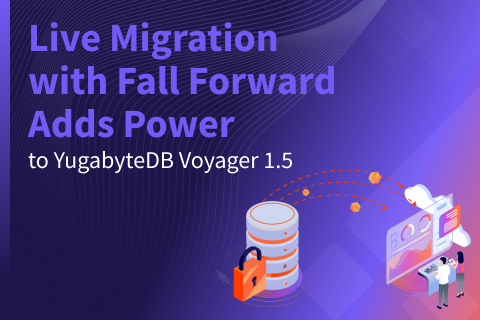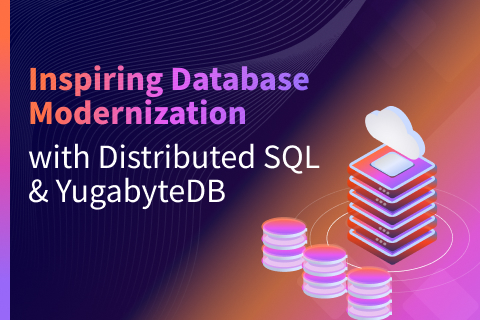Discover Three Key Data Migration Approaches
The Need for Database Migration in Modern IT
If you run modern business applications on yesterday’s technology, you’ll spend more time dealing with infrastructure than innovating. Companies and enterprises built on legacy, monolithic relational databases need to consider migrating to cloud‑native, distributed database platforms to stay competitive.
Migration enables organizations to adopt modern technologies (like distributed SQL), achieve cloud‑native agility, and comply with increasingly stringent global and local regulations. It also enables them to meet customer expectations for 24/7 uptime and instant scalability, which monolithic databases often struggle with. The ability to move databases from on‑premises systems or proprietary platforms into a flexible distributed environment is critical for innovation.
Yugabyte works with engineering leaders who often struggle with scaling, availability, and global performance. In a recent DSS Asia case study, Mindgate Solutions discussed how they moved their real‑time payments system from a legacy relational DBMS to YugabyteDB, a distributed SQL database, to overcome the inability of their monolithic system to deliver horizontal scale or active–active availability.
Yugabyte simplifies migration by supporting familiar PostgreSQL tools and providing a free, open‑source migration tool (YugabyteDB Voyager) to make migrations repeatable and safe.
Recent customer stories underline why organizations are looking for modern, resilient databases and demonstrate that migration doesn’t have to be painful when you use the right strategy, tools, and partners.
What Are the Three Major Types of Data Migration?
1. Big‑Bang (Lift‑and‑Shift) Migration
A big‑bang migration moves all your data in one go:
- Stop your applications
- Move the entire dataset
- Restart on the new database
A “lift‑and‑shift” strategy is fast, relatively simple, and can be less costly than other approaches. A major downside is that your existing system is unavailable during the cutover, and the process carries the risk of an expensive failure if something goes wrong.
Big‑bang migrations are best for small datasets or situations where downtime can be scheduled.
2. Phased/Trickle Migration
In a phased or trickle migration, data moves in small, incremental steps while the legacy and new systems run in parallel. This approach reduces downtime, allowing for continuous testing and adjustments.
Because each sub‑migration has its own scope, objectives, and timeline, phased migrations are less prone to catastrophic failure. However, they take longer and require extra effort to keep both systems synchronized.
This approach is ideal for large datasets or mission‑critical systems that can’t risk a lenthy outage.
3. Parallel/Hybrid Migration
Parallel or hybrid migrations combine big‑bang and phased techniques. The old and new systems run simultaneously, and data synchronization mechanisms keep them aligned. Once the new environment is fully validated, you can switch traffic over and decommission the old system.
Hybrid migrations strike a balance between the speed of a big-bang approach and the reduced risk of phased migrations. They’re useful when some parts of the application can tolerate downtime (and be migrated in bulk) while other parts require continuous operation.
Different Data Migration Types
Migration strategies describe how you move data, but a comprehensive migration program may involve one or several of the following:
| Migration types | Description | Typical use cases |
| Storage migration | Moving data from one storage system to another, often from on‑premises disks to solid‑state drives or cloud storage | Technology refresh, replacing outdated hardware, and digitizing paper archives |
| Cloud data migration | Transferring data from on‑premises systems to a cloud‑based system or between clouds | Moving to a public cloud or multi‑cloud, and disaster recovery |
| Database migration | Moving data from one database or DBMS to another | Upgrading from a legacy database to a modern distributed SQL database like YugabyteDB |
| Application migration | Transferring an application and its data from one environment to another | Re‑platforming monolithic apps to microservices or Kubernetes |
| Data‑center migration | Moving all hardware, software, and data from one data center to another | Mergers, acquisitions, and relocation of facilities |
| Business‑process migration | Moving business processes (e.g., HR, billing) and their data between systems | Consolidation after mergers, or process modernization |
These migration types often overlap; for example, migrating a monolithic database to a distributed SQL service may involve a database migration combined with an application migration and, if you’re moving to the cloud, a cloud data migration.
Read this recent article to find out more about database migration and how to plan one.
What Are the Three Data Migration Stages?
Regardless of the strategy or migration type, each project follows a similar three‑stage lifecycle: planning and assessment, execution, and validation.
Stage 1: Planning and Assessment
This stage lays the groundwork for a successful migration. Start by assessing and cleaning your source data, evaluating its size, stability, and quality. This includes mapping the source and target schemas, defining what data will be migrated, and establishing data quality controls. You also design the migration architecture, set budgets and timelines, and brief stakeholders on the plan.
Performing a thorough assessment helps you decide which migration strategy (big‑bang, trickle, or hybrid) is appropriate.
In the context of distributed SQL, assessment includes evaluating whether the application would benefit from horizontal scaling, multi‑region deployments, and high availability. Tools like YugabyteDB Voyager provide an assessment feature that analyzes schemas and data types and highlights potential issues before the migration begins. This helps you fine‑tune the plan and choose between offline and live migration options.
Stage 2: Migration Execution
During execution, you implement the migration plan. For big‑bang migrations, you export all schemas and data, transform them if necessary, and load them into the new database. For phased or hybrid migrations, you run the old and new systems in parallel, transferring data incrementally and keeping them synchronized.
It’s crucial to monitor progress and perform continuous testing to detect issues early. YugabyteDB Voyager’s unified CLI allows you to export schemas, import data, and resume failed jobs, while progress bars provide expected completion times.
Stage 3: Validation and Optimization
After your data is migrated, you must validate that everything has been transferred correctly. This involves checking that all required data exists, values are accurate, and referential integrity is maintained.
Post‑migration optimization includes performance tuning, indexing, and configuration adjustments to ensure the new system meets service‑level agreements. For example, distributed SQL databases allow you to tune replication factors or placement policies to meet latency and compliance requirements. Once validation is complete, you can decommission the old system and realize cost and efficiency savings.
Key Considerations for Crafting a Data Migration Strategy Document
To create a robust migration strategy document, you need to know where you’re starting, the route you’ll take, and what to do if something goes wrong.
A well‑crafted strategy document should include the following components:
- Project scope and objectives: Define which datasets, schemas, and applications will be migrated and why. Clarify business drivers such as scalability, regulatory compliance, or cost reduction.
- Stakeholders and roles: Identify everyone involved, from database engineers and architects to business owners and SREs. Assign clear responsibilities and establish communication channels.
- Timeline and milestones: Outline key phases, estimated durations, and dependencies. Provide a rollback plan in case issues arise. A phased migration plan may span months or even years.
- Data assessment and cleanup: Document the results of data audits, including data quality issues, duplicates, and anomalies. Plan for data cleansing before migration.
- Backup and recovery plan: Describe how data will be backed up and restored in case of failure.
- Technology and resource requirements: List the tools, hardware, and personnel needed. Evaluate whether additional staff or external consultants are required.
- Security and compliance: Specify encryption, access controls, and compliance measures. Distributed databases often span multiple regions; ensure data residency and governance policies are addressed.
- Testing and validation: Include test plans for schema conversion, data transfer, and application functionality. Plan for parallel runs and user acceptance testing.
Using a data migration strategy template or checklists can accelerate planning. YugabyteDB Voyager’s structured process (assessment, schema export/import, data export/import, cutover, and archive) serves as an effective template. It allows you to export data, monitor progress, tune parallelism, and resume jobs on failure.
Because YugabyteDB Voyager is open source and supports multiple source databases, you’re not tied to a single vendor, which aligns with modern IT teams’ desire to avoid lock-in.
Conclusion
Data migration is more than a technical exercise; it’s a strategic initiative that enables your business to evolve.
By understanding the three major migration approaches (big‑bang, phased/trickle, and hybrid), the types of migration you may undertake, and the stages involved in a migration project, you can make the right choices to ensure business success. Proper planning, continuous testing, and a thorough validation step are vital to avoid unpleasant surprises.
At Yugabyte, we’ve seen how moving from monolithic databases to a cloud‑native, distributed SQL platform unlocks new possibilities for our customers.
Whether you’re modernizing a core banking application, scaling a real‑time payments platform, or preparing your e‑commerce site for global traffic, a thoughtful migration strategy combined with tools like YugabyteDB Voyager will set you up for success.
Our experts are available to help you navigate your modernization journey. Contact us to explore how distributed databases can support your next-gen applications.


